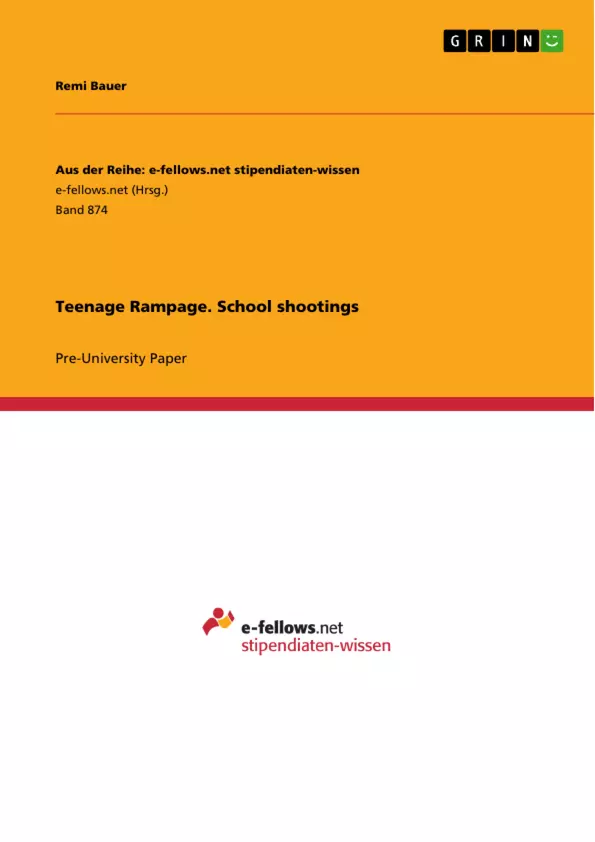“After I mow down a whole area full of you snotty-ass rich motherfucker high-strung God-like-attitude-having worthless pieces of shit whores, I don’t care if I live or die.” With provocative quotes like this one, Eric Harris announced his merciless school shooting. Together with Dylan Klebold, he committed the Columbine massacre - the worst carnage ever perpetrated by teenagers in the United States. On 18 April, 1999, the two youngsters entered Columbine High School in Littleton, Colorado, heavily armed. Their arsenal included “two sawn off shotguns, [a] 9mm Hi-Point carbine rifle, [a] TEC-DC-9 semi-automatic pistol and a total of 95 explosive devices.” Regardless of the consequences Harris and Klebold methodically killed their fellow students. A total of thirteen dead and twenty-three wounded people was the sad result of this atrocious act. After the bloodbath the American people wondered why warning signs were not taken serious and how such a bloody deed could take place in a suburban area in Colorado. Even so, the Columbine massacre was not a singular instance, it was the incident that drew attention to school shootings. Before the deadly homicide Eric Harris recorded a message saying “People will die because of me … It will be a day that will be remembered forever.” Tragically, he was proved right. People all over the world kept the shooting in mind and, in addition to it, the idiom ‘pull a Columbine’ was append to the American encyclopedia. Because of the fatal carnage, people became aware of a big problem in society. There have been heated controversies about the homicides themselves questioning if the legal custodian, violent music, weapons of the shooters or the system of cliques which is part of the normal high school life should be blamed. Also, the aftermaths of the schoolyard shootings and prevention methods which should be introduced were discussed in public. The following paper will give a valuable insight into the topic.
Table of Contents
- Introduction
- Shootings
- Definition of a school shooting
- History of school shootings
- Causes of school shootings
- Mental Illnesses
- Social trouble
- Gun availability
- Violent media
- Combinations of factors
- The Shooters
- Aftermaths of school rampages
- How victims cope with the shootings
- What became of the shooters
- The copycat effect
- Prevention methods
- Gun Control
- Restrictions of violent media
- What schools can do
- Conclusion
Objectives and Key Themes
This paper aims to provide a comprehensive analysis of school shootings, exploring their historical context, causes, and aftermaths. The paper will also examine various prevention methods proposed to combat this complex issue.- The definition and historical context of school shootings.
- The diverse causes of school shootings, including mental illness, social problems, and the influence of media.
- The impact of school shootings on victims, perpetrators, and society.
- Potential prevention methods, such as gun control and media restrictions.
- The societal implications of school shootings and the need for comprehensive solutions.
Chapter Summaries
- Introduction: The paper begins by introducing the Columbine massacre as a pivotal event that brought the issue of school shootings to the forefront of public awareness. It highlights the various controversies surrounding these events, including the role of mental health, media, and social factors.
- Shootings: This section delves into the definition of a school shooting, outlining the criteria that differentiate these events from other acts of violence. It then explores the history of school shootings, tracing their evolution from isolated incidents to a more frequent phenomenon, particularly in the 1990s.
- Causes of school shootings: This chapter examines various factors that may contribute to school shootings, including mental illnesses, social difficulties, gun availability, violent media, and combinations of these factors. It discusses the role of mental health, social alienation, and the impact of media on the minds of potential perpetrators.
- Aftermaths of school rampages: This section explores the long-term consequences of school shootings, focusing on the experiences of victims, the fate of perpetrators, and the potential for copycat effects. It delves into the psychological trauma of survivors and the societal repercussions of these tragedies.
- Prevention methods: This chapter examines various preventative measures proposed to combat school shootings, including gun control, restrictions on violent media, and proactive interventions by schools. It explores the effectiveness of these measures and the ongoing debate surrounding gun control and media influence.
Keywords
This paper centers on the critical themes of school shootings, violence, mental health, social factors, media influence, prevention methods, gun control, and societal implications. The analysis explores the complexities of these issues, seeking to understand the causes of these tragic events and identify potential solutions for mitigating future occurrences.- Citation du texte
- Remi Bauer (Auteur), 2007, Teenage Rampage. School shootings, Munich, GRIN Verlag, https://www.grin.com/document/266434



